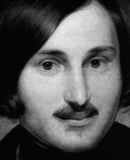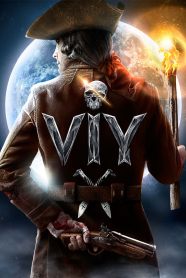
Nikolay Gogol
Nikolay Gogol
Writer
Nikolai Vasilievich Gogol (31 March 1809 – 4 March 1852) was a Russian dramatist of Ukrainian origin. Although Gogol was considered by his contemporaries to be one of the preeminent figures of the natural school of Russian literary realism, later critics have found in his work a fundamentally romantic sensibility, with strains of surrealism and the grotesque ("The Nose", "Viy", "The Overcoat", "Nevsky Prospekt"). His early works, such as Evenings on a Farm Near Dikanka, were influenced by his Ukrainian upbringing, Ukrainian culture and folklore. His later writing satirised political corruption in the Russian Empire (The Government Inspector, Dead Souls). The novel Taras Bulba (1835) and the play Marriage (1842), along with the short stories "Diary of a Madman", "The Tale of How Ivan Ivanovich Quarreled with Ivan Nikiforovich", "The Portrait" and "The Carriage", are also among his best-known works. Gogol was born in the Ukrainian Cossack town of Sorochyntsi, in Poltava Governorate of the Russian Empire, present-day Ukraine. His mother descended from Leonty Kosyarovsky, an officer of the Lubny Regiment in 1710. His father Vasily Gogol-Yanovsky, a descendant of Ukrainian Cossacks (see Lyzohub family) and who died when Gogol was 15 years old, belonged to the 'petty gentry', wrote poetry in Ukrainian and Russian, and was an amateur Ukrainian-language playwright. As was typical of the left-bank Ukrainian gentry of the early nineteenth century, the family spoke Ukrainian as well as Russian. As a child, Gogol helped stage Ukrainian-language plays in his uncle's home theater. In 1820, Gogol went to a school of higher art in Nezhin (now Nizhyn Gogol State University) and remained there until 1828. It was there that he began writing. He was not popular among his schoolmates, who called him their "mysterious dwarf", but with two or three of them he formed lasting friendships. Very early he developed a dark and secretive disposition, marked by a painful self-consciousness and boundless ambition. Equally early he developed a talent for mimicry, which later made him a matchless reader of his own works and induced him to toy with the idea of becoming an actor. In 1828, on leaving school, Gogol came to Saint Petersburg, full of vague but glowingly ambitious hopes. He had hoped for literary fame, and brought with him a Romantic poem of German idyllic life – Hans Küchelgarten. He had it published, at his own expense, under the name of "V. Alov." The magazines he sent it to almost universally derided it. He bought all the copies and destroyed them, swearing never to write poetry again. Gogol was in touch with the "literary aristocracy", had a story published in Anton Delvig's Northern Flowers, was taken up by Vasily Zhukovsky and Pyotr Pletnyov, and (in 1831) was introduced to Pushkin. Pushkin's death produced a strong impression on Gogol. His principal work during the years following Pushkin's death was the satirical epic Dead Souls. Concurrently, he worked at other tasks – recast Taras Bulba and The Portrait, completed his second comedy, Marriage (Zhenitba), wrote the fragment Rome and his most famous short story, "The Overcoat". In 1841 the first part of Dead Souls was ready, and Gogol took it to Russia to supervise its printing. It appeared in Moscow in 1842, under the title, imposed by the censorship, of The Adventures of Chichikov. The book instantly established his reputation as the greatest prose writer in the language. After the triumph of Dead Souls, Gogol's contemporaries came to regard him as a great satirist who lampooned the unseemly sides of Imperial Russia. Little did they know that Dead Souls was but the first part of a planned modern-day counterpart to the Divine Comedy of Dante. The first part represented the Inferno; the second part would depict the gradual purification and transformation of the rogue Chichikov under the influence of virtuous publicans and governors – Purgatory. In April 1848 Gogol returned to Russia from a pilgrimage to Jerusalem and passed his last years in restless movement throughout the country. While visiting the capitals, he stayed with friends such as Mikhail Pogodin and Sergey Aksakov. During this period, he also spent much time with his old Ukrainian friends, Maksymovych and Osyp Bodiansky. He intensified his relationship with a starets or spiritual elder, Matvey Konstantinovsky, whom he had known for several years. Konstantinovsky seems to have strengthened in Gogol the fear of perdition by insisting on the sinfulness of all his imaginative work. Exaggerated ascetic practices undermined his health and he fell into a state of deep depression. On the night of 24 February 1852 he burned some of his manuscripts, which contained most of the second part of Dead Souls. He explained this as a mistake, a practical joke played on him by the Devil. Soon thereafter, he took to bed, refused all food, and died in great pain nine days later.Gogol was mourned in the Saint Tatiana church at the Moscow University before his burial and then buried at the Danilov Monastery, close to his fellow Slavophile Aleksey Khomyakov. His grave was marked by a large stone (Golgotha), topped by a Russian Orthodox cross. In 1931, Moscow authorities decided to demolish the monastery and had Gogol's remains transferred to the Novodevichy Cemetery.His body was discovered lying face down, which gave rise to the story that Gogol had been buried alive. The authorities moved the Golgotha stone to the new gravesite, but removed the cross; in 1952 the Soviets replaced the stone with a bust of Gogol. The stone was later reused for the tomb of Gogol's admirer Mikhail Bulgakov. In 2009, in connection with the bicentennial of Gogol's birth, the bust was moved to the museum at Novodevichy Cemetery, and the original Golgotha stone was returned, along with a copy of the original Orthodox cross. The first Gogol monument in Moscow, a Symbolist statue on Arbat Square, represented the sculptor Nikolay Andreyev's idea of Gogol rather than the real man. Unveiled in 1909, the statue received praise from Ilya Repin and from Leo Tolstoy as an outstanding projection of Gogol's tortured personality. Joseph Stalin did not like it, however, and the statue was replaced by a more orthodox Socialist Realism monument in 1952. It took enormous efforts to save Andreyev's original work from destruction; as of 2014 it stands in front of the house where Gogol died.
For more information press the link below:
https://en.wikipedia.org/wiki/Nikolai_Gogol
